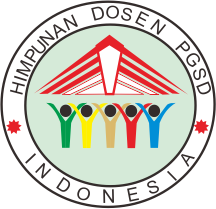PROSES BERPIKIR PSEUDO SISWA PADA PEMBELAJARAN MATEMATIKA MATERI PECAHAN
DOI:
https://doi.org/10.23969/jp.v9i3.18992Keywords:
Pseudo-Thinking, True-Pseudo, False-Pseudo, FractionsAbstract
Mathematical thinking errors in elementary school or pseudo-thinking have not yet become the focus of more attention when solving fraction problems. Therefore, this research aims to describe about the pseudo-thinking of elementary school students in solving fraction problems so that a picture of the pseudo-thinking conditions experienced by students can be known. This researchs’ method used is qualitative research with a qualitative descriptive research type involving 15 fifth grade students of SD Negeri 39 Parepare. We chose research subjects with a purposive technique and based on students' ability to communicate answers well and clearly through interviews. Data were collected used interviews and tests which were then analyzed descriptively. The findings of this study indicate that students experience pseudo-thinking conditions in solving problems about fractions. The pseudos experienced are false-pseudo and true-pseudo. Students experience true-pseudo thinking conditions when students are unable to express the right reasons for the answers given according to the concepts used. As for when students experience false-pseudo thinking conditions in the wrong answer condition, namely when giving spontaneous but wrong answers caused by guessing the answer so that reflection on the answer is carried out through improving understanding.Downloads
References
Alamsyah, A., Susiswo., & Hidayanto, E. (2019). Berpikir Pseudo Siswa pada Konsep Pecahan. Jurnal Pendidikan: Teori, Penelitian, dan Pengembangan. 4(8). 1060-1070. http://dx.doi.org/10.17977/jptpp.v41i8.13041.
Anggraini, D., Kusmayadi, T.A., & Pramudya, I. (2018). Construction of the Mathematical Concept of Pseudo Thinking Students. Journal of Physics: Conference Series. 1022(1).1-10. http://doi.org/10.1088/17426596/1022/1/012010
Baharuddin., Khadijah., & Masni. (2024). Keefektifan Pembelajaran Missouri Mathematics Project dengan Pendekatan Problem Solving terhadap Kemandirian Belajar. Jurnal Riset HOTS Pendidikan Matematika. 4(1). 327-338. https://doi.org/10.51574/kognitif.v4i1.1196.
Haryono, D. (2014). Filsafat Matematika. Bandung: Alfabeta.
Hayati, I. N., Subanji, & Qohar, A. (2016). Berpikir Pseudo Siswa dalam Memecahkan Masalah PISA. Jurnal Pembelajaran Matematika, 3(1), 10–15.
Ismiasih, N. (2024). Defragmenting Berpikir Pseudo Siswa dalam Menyelesaikan Soal Aljabar Matematika. Linear: Journal of Mathematics Education. 5(1). 45-53. https://doi.org/10.32332/linear.v5i1.8161
Liu, W., Pan, Y., Luo, X., Wang, L., & Pang, W. (2017). Active Procrastination and Creative ideation: The Mediating Role of Creative Self-Efficacy. Personality and Individual Differences. 119, 227-229. https://doi.org/10.1016/j.paid.2017.07.033.
Muslim, R.I., Usodo, B., & Pratiwi, H. (2021). Pseudo Thinking Process in Understanding the Concept of Exponential Equations. Journal of Physics: Conference Series. 1808(1). 1-10. https://doi.org/10.1088/1742-6596/1808/1/012043.
Nizaruddin & Kusmaryono, I. (2023). Transforming Students’ Pseudo-Thinking into Real Thinking in Mathematical Problem Solving. International Journal of Educational Methodology. 9(3). 477-491. https://doi.org/10.12973/ijem.9.3.477.
Proudfoot, D., Kay, A. C., & Koval, C. Z. (2015). A Gender bias in the attribution of creativity: Archival and experimental Evidence for the Perceived Association between Masculinity and Creative Thinking. Psychological Science. 26(11). 1751-1761. https://doi.org/10.1177/09567976155987
Puente-Diaz, R., & Cavazos-Arroyo, J. (2017). The Influence of Creative Mindsets on Achievements Goals, Enjoyment Creative Self-Efficacy and Performance among Business Students. Thinking Skills and Creativity. 24, 1-11. https://doi.org/10.1016/j.tsc.2017.02.007
Rafiah, H., Saufi, M., Aulia, S., & Riadi, A. (2018). Berpikir Pseudo Mahasiswa PGSD pada Operasi Bilangan Bulat. Math Didactic: Jurnal Pendidikan Matematika, 4(1), 11–20. https://doi.org/http://jurnal.stkipbjm.ac.id/index.php/math
Subanji. (2013). Proses Berpikir Pseudo Siswa dalam Menyelesaikan Masalah Proporsi. J-TEQIP. Tahun IV, Nomor 2.
Suherman, S. & Vidakovich, T. (2024). Role of Creative Self-Efficacy and Perceived Creativity as Predictors of Mathematical Creative Thinking: Mediating Role of Computational Thinking. Thinking Skills and Creativity. 53, 1-14. https://doi.org/10.1016/j.tsc.2024.101591
Syahraini, A., Priatna, N., & Suhendra, S. (2023). Students’ Pseudo Thinking Process in Solving SPLDV Problems Based on Polya’s Stages. Jurnal Analisa, 9(1), 12-21. https://doi.org/10.15575/ja.v9i1.26543.
Vinner, S. (1997). The Pseudo-Conceptual and the Pseudo-Analytical Thought Processes in Mathematics Learning. Educational Studies in Mathematics, 34(November), 97–129. https://doi.org/10.1023/A
Wibawa, K. A. (2014). Defragmenting Proses Berpikir Melalui Pemetaan Kognitif Untuk Memperbaiki Berpikir Pseudo Siswa Dalam Memecahkan Masalah Limit Fungsi. Tesis. Program Studi Pendidikan Matematika, Pascasarjana Universitas Negeri Malang
Downloads
Published
Issue
Section
License
Copyright (c) 2024 Pendas : Jurnal Ilmiah Pendidikan Dasar

This work is licensed under a Creative Commons Attribution 4.0 International License.



















